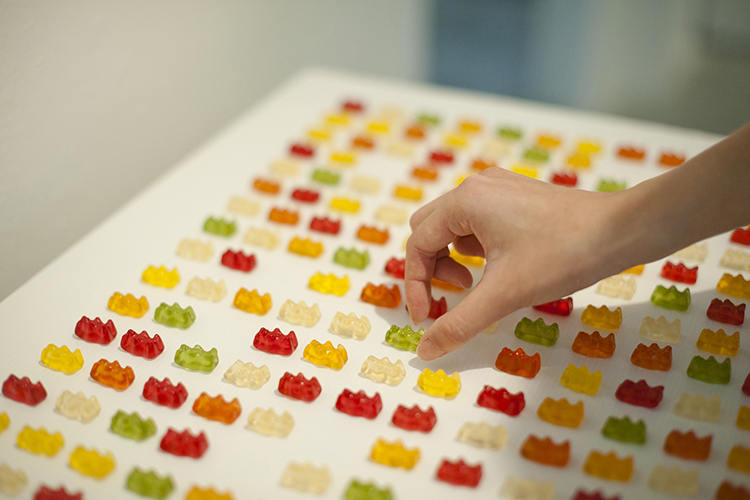
Halal Gummy Bears (in green) were laid out among non-Halal ones at the Eating Together exhibition to challenge visitors to consider the care they needed to take in eating among others with dietary restrictions. A visitor pointed out how vegetarians were excluded from this installation because gummy bears contain beef gelatin. PHOTO: Clarence Aw
It is the simplest of features found on many food packaging. A tear, a jagged edge, or a perforated line—a godsend to anyone who has struggled to open a packet of chips. These designs conveniently replace the need for brute force, and are considerate gestures from food manufacturers that have thought carefully about how we eat.
Eating, or the journey that food takes to get into our mouths (and even within our bodies), is a logistical issue many of us take for granted. This global movement of crops and livestock, from a farm through a processing facility, to a market, into a kitchen, on a dining table, and finally, entering as food inside our stomachs, is one facilitated by design at every turn. We don’t have to travel far to see examples: start with the plate, spoon, and fork, on the dining table, the most ubiquitous tools the world eats with today. They stand in for our bare hands and function in ways we cannot. Plates divide food into portions, spoons let us sip hot soup, while forks help us pick out the tiniest of ingredients.
Just as punctuation makes a string of words a sentence, design turns food into a meal. It is never the main course, but from the margins of food, design directs how we eat. An elaborate plate like an exclamation mark calls attention to what is on it. A ten-course meal is served in a sequence just as how hyphens connect letters to spell out a wedding banquet. Layers upon layers of packaging act like ellipses, building anticipation (or frustration) for what lies within. Design is an integral part of our dinner conversation, not always verbally, but certainly in the ways we eat.
This is especially so when eating together with others. Much has been said about how food brings different people together, and while that potential exists, it is not as simple as it seems. Just think of the rowdy crowd at the next table or an awkward family dinner—to eat together means having a conversation with people of different values and tastes. Design offers a material language to negotiate these dynamics.
Consider the dining table, a platform where meals plays out. Belying its horizontal disposition are considerations that can include and exclude. In Singapore’s coffeeshops, better known as kopitiams, round tables with accompanying portable polypropylene chairs are favored by proprietors because of the flexibility it offers. They maximize seating capacity and also inadvertently encourage strangers to dine with one another. Diners at a round table can never completely avoid one another—the further they sit apart, the more direct their line of sight is. The sharp edges of rectangular or square tables are often used to determine seating numbers, and even demarcate hierarchy when someone sits at the head of the table. It is no surprise then that we eat with a “circle of friends,” but never a square or rectangle of them.
To read the entire article and more about the intersection of design + food, pick up a copy of Observer Quarterly Number 3.

